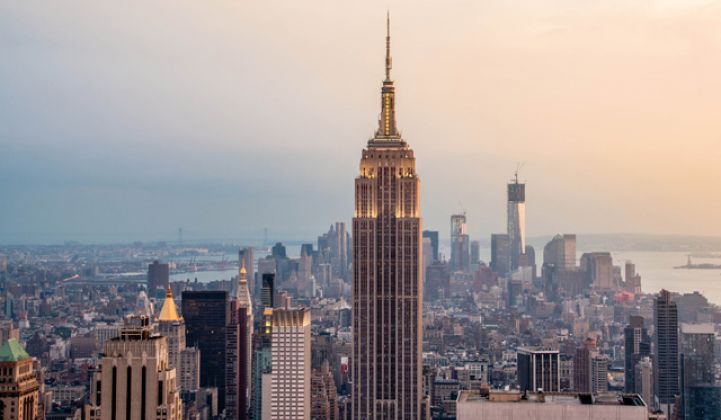Only two U.S. states, California and Massachusetts, have set targets for energy storage deployments. Now New York City has joined them.
The city government unveiled a storage goal of 100 megawatt-hours by 2020 last week, along with an expanded solar target of 1,000 megawatts by 2030. Storage, with its capacity to integrate variable wind and solar power sources into the grid, is expected to play a critical role in meeting the city's plans to cut greenhouse gases by 80 percent by 2050.
Storage experts told GTM that this is the first time a city has set such a target.
The city's target is not a legally binding requirement like California's. It's more of an aspirational target with policies designed to make the process easier.
"With a city-based target, they are also directly responsible for building codes and siting regulations, deployment strategies and even local taxes -- and the city can also take steps to adapt all these rules and regulations to accelerate deployment," wrote Matt Roberts, executive director of the Energy Storage Association, in an email. "The city is able to marshal its forces toward this collective goal, and can more easily adjust the goal based on the observed value delivered in the future."
The New York City target applies to the full spectrum of storage, including electrochemical and thermal technologies. City officials are targeting storage as a way to reduce demand charges, defer distribution system upgrades, pre-cool buildings and shift solar power consumption.
For all the potential use cases, energy storage is still a bit player in the city's energy system. A major motivation for the storage target is to make permitting easier, said Daniel Zarrilli, senior director of climate policy and programs with the city.
Currently, getting a storage system approved is "largely a one-off process where it's pulled out of a queue and dealt with specifically because it’s unique," he said. "We don’t want people thinking, ‘Oh, I want to put in storage, but it may be too hard.'"
That's how solar permitting was in the early days, but then the city set a target in 2014 to get 100 megawatts of public solar and 250 megawatts of private solar by 2025. This spurred an increase in deployments and a streamlining of the city's procedures.
"We’ve been using that target as a way to knock down some of the internal bureaucratic hurdles," Zarrilli said. The hope is something similar will happen with storage.
Energy storage makes a lot of sense for New York City, said Daniel Finn-Foley, a senior analyst for energy storage at GTM Research.
"It's easy to forget that Manhattan is an island, with all the associated complications, but you'd be reminded if you ever tried to plan transmission systems into the city," he said. "Its capacity prices are quite high -- the latest strip auction for the NYISO capacity market cleared at $10.99/kW-month, compared to $3.62 across much of the rest of the state."
Most recent growth in storage capacity nationwide has been driven by cheaper lithium-ion batteries, but the New York City Fire Department and the Department of Buildings are still figuring out the safety implications of this new technology. Lithium-ion chemistries carry some degree of risk for fires, and the city wants to feel secure before adding them into the highly dense region.
A block on lithium-ion would force developers to focus on other technologies, which might not be the cheapest or most efficient for a particular use case. The city has plenty of other options to work with though. The Metropolitan Transit Authority, for instance, is trying out a 400-kilowatt-hour vanadium redox flow battery in downtown Manhattan. That technology is known for its safe components and long-duration performance.
GTM wasn't able to find a tally of storage deployments in the city so far, but GTM Research forecasts the state of New York will have an annual market of 273 megawatt-hours in 2020. So if a strong share of the state's deployments go to its largest city, the 100-megawatt-hour target should be doable.
That leaves the question of which city will be next.



